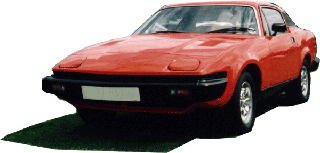A True TR7
As has been well documented by others (please check out our 'Links' and read Tony Jackson's well researched page, for an in-depth history of the model) there were many political and economic factors which had to be taken into consideration, when finalising the design and the powerplant of the TR7. This being the case many compromises had to be made:
- The under-powered 2.0litre 'slant 4' engine.
- A 4-speed Gearbox .
- Using a monocoque shell.
- And the horror of a fixed-lid!
It was probably the fixed-lid more than anything else which really stuck in the throat of the TR purist; many also saw the drop in top-end speed and poor 0-60mph times - when compared to the TR6 as a backward step. However with any engine much larger than 2.0l likely to hit political problems (not to mention the fuel-crisis) in the USA and the, relatively, unreliable 16v engine used in some TR6's there were not many options open to them without going seriously over budget - which was not a viable option for cash-strapped British Leyland. In hindsight the 'unreliable' 16v unit would not have impaired the image of the TR7 greatly - such was the atrocious build quality of the early, Speke built, models.

Traditionalists and long-time enthusiasts of the TR Marque see the TR6 as the last proper 'TR'. This is chiefly due to the fixed lid of the early TR7 models and the revolutionary look of the new TR. Over time this attitude seems to have relaxed a little - even to the point where a TR6 driver waved to me as I sat behind him in traffic!! Is this because those people now realise that the TR7 has made a valuable contribution to the TR range? Or maybe is it just because it's another Triumph that's still on the road? Indeed the only non-true TR is the TR8!! Had British Leyland followed the naming conventions, used previously by Triumph, this car would have emerged as the TR7a; leaving the TR8 available for another body styling!
The TR7 nowadays still doesn't look all that dated - certainly not its 27 years! Indeed the DHC looks as if it may have rolled off a production line just a couple of years ago, more so if it's been fitted with larger, more attractive alloys. Probably the only thing that marks the car out, as being a product of the 70's, is the rear light clusters and the panel that holds them; the rather small headlamps and the tiny sidelights..... and we'll ovelook the tartan interior!!!
(Articles provided from http://www.triumphtr7.com)

0 Comments:
Post a Comment
<< Home